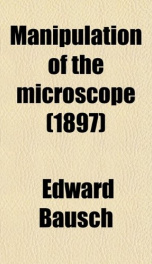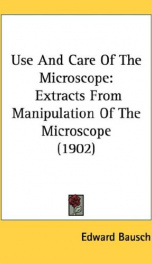manipulation of the microscope

Purchase of this book includes free trial access to www.million-books.com where you can read more than a million books for free. This is an OCR edition with typos. Excerpt from book: vantages, such as the necessity of holding the base when adjusting the magnifier and the danger to the eye from the projecting stem. The Excelsior Dissecting Microscope (-Fig. 19) can be recommended when portability is a desideratum and for school use in primary work, the dissecting microscope designed by Prof. C. R. Barnes. This meets many conditions of a dissecting microscope in a simple manner. There is a variety of more complex forms, giving a number of advantages, such as stability convenience of varied illumination, delicate means for and long range of adjustment, jointed arms for moving the lens conveniently over a large field, etc., to the various descriptions of which the reader is referred to catalogues. How to use Magnifiers and Dissecting Microscopes.It is generally admitted that the intelligent use of a magnifier is a great aid in microscopical studies and while its use is a simple matter, some words of advice may be of aid in obtaining better results, or lead to doing work with more comfort. In all work, whether with simple or compound microscopes, it is a good plan to start out with the principle not to use a greater magnifying power than is necessary to accomplish the results in view. // should be made a habit at the outset to keep both eyes open. Keep the eye comfortably near to the upper surface of the lens, as the angular view is increased and there is the least spherical aberration and the focal distance is the greatest. This can be easily tested by gradually increasing the distance between the eye and lens, when it will be found that the lens must be brought nearer to the object. In single lenses the spherical and chromatic aberrations become more pronounced and the field smaller. As magnifiers which are used on opaque objects those which ...
Info about the book
Author:
Series:
Unknown
ASIN:
B003A835KG
Rating:
5/5 (1)Your rating:
0/5
Languge:
English
Users who have this book
Users who want this book
What readers are saying
What do you think? Write your own comment on this book!
write a commentif you like manipulation of the microscope try:
Other books by this author
Do you want to exchange books? It’s EASY!
Get registered and find other users who want to give their favourite books to good hands!


